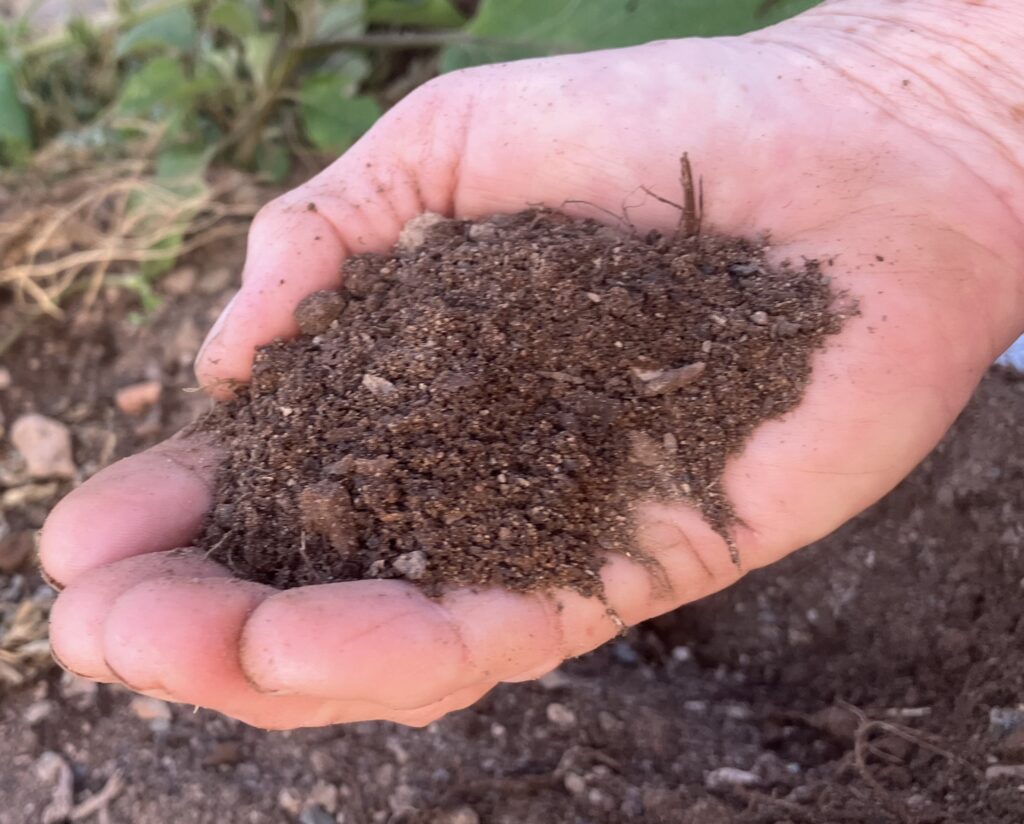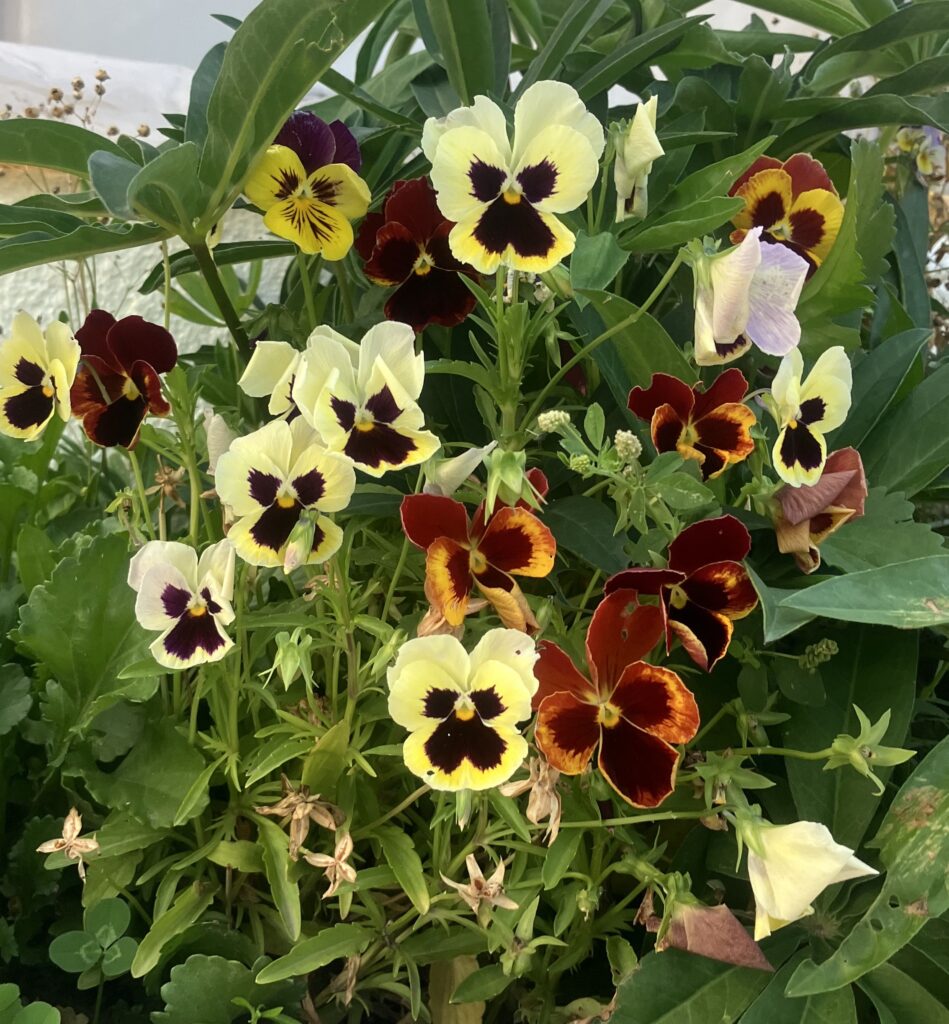Gardening from the underside…
October 24, 2025

Our goal as a gardener is to create the best conditions for our plants, so that they can realize their full potential.
It is easy to assess the amount of sun, wind and the water they receive, but while the foliage and flowers get all the praise and glory, we only see half the story. The roots do a lot of the heavy lifting, labouring away, uncelebrated in the dark. Understanding how well the roots are being served by the soil is the gardener’s challenge.
The work of the root is to grow through the soil and absorb moisture and nutrients, and create an anchor to hold the plant in place, and upright. The qualities of the soil dictate how well the roots do, and ultimately the gardener’s job is to create a “healthy soil,” encouraging a teeming ecosystem of insects, fungi, and bacteria that make soil nutrients available for roots.
We gauge how good our soil is largely by how sandy or clayey its texture is, and it’s good to see a darker brown colour, which indicates a good amount of organic matter.
The texture of the soil – whether clayey, sandy, or loamy – defines whether the roots have access to the moisture and air they need. Inverness County soil is most often very clayey or very sandy, so it can benefit from getting the texture balanced a bit by adding one or the other, and in most cases, adding organic matter.

When you consider the fertility of the soil, there are three main soil nutrients needed by your plants, and each has different benefits:
Nitrogen (N) encourages lush growth of leaves.
Phosphorus (P) supports healthy roots, flowers, and fruits.
Potassium (K) is good for all-around plant health.
Fertilizer packaging often displays its “NPK value,” like 10:14:10, to reflect its best use. This example would support root and flower production because of the higher middle number – phosphorus. A nitrogen-rich fertilizer wouldn’t be ideal if you’re growing tomatoes, because you want fruit, not leaves.
You can enrich your soil from a number of sources, either organic or inorganic. The term “organic,” in the soil context, just means a material that comes from once-living things, and will decay to enrich your soil. Organics like manure, leaves, seaweed, grass, mulch, and bone meal, also help to hold moisture, discourage erosion, while also creating texture to create air pockets that keep roots aerated.
Because organics aren’t “manufactured,” they aren’t usually sold with measured NPK values, but their qualities are easily found. Manure is famously high in nitrogen, while bone meal is high in phosphorous, and wood ash is a good source of potassium. As natural materials, organics also contain a wide range of micronutrients, the minerals and compounds needed in small amounts.
Organics generally break down gradually, meaning they can be added at any time of the year. However, late summer/early fall fertilizing is not ever recommended because it might encourage too much new growth when plants should be preparing for winter.
“Inorganic” materials arise from non-living materials, like lime or calcium. They naturally occur in the soil but can also be manufactured and sold with NPK values as conventional granular fertilizers. These are available in fast-release and slow-release forms.
In fast release form, you need to be careful of the timing and conditions when you apply inorganic fertilizers, such as temperature, rainfall, and stage of growth of the plant. Inorganic fertilizers, in many cases, are applied when the crop is actively growing, so that the released minerals are taken up by the crop right away. Each has its particular use, but these fertilizers lack the broad range of micro nutrients found in most organic fertilizers.
The main caution with inorganic fertilizer is that too much use causes rapid breakdown of organic matter, so soil texture and overall soil health deteriorates over time. In many cases, it is best used alongside organics. A healthy balance of theses soil components makes for happy microorganisms and insects that continually enrich your soil.
The fertility of the soil is not just determined by what minerals are present, but also by how the soil’s acidity changes the form of the nutrients, making them more or less available to the roots. Typically, soils in these parts run acidic, and most crops are fine with this, but they are often happier with a slightly acidic pH. This factor takes a while to remedy, either by adding peat (for acidity), or lime (to make more basic).
Unusually high or low pH would challenge most plants, so it’s good to know where you stand. Soil testing through the Department of Agriculture is worth following up on. With that information, you can learn more about the right fertilizer, application time, and quantity. Soil health is a longer-term project, but the dividends are priceless.
Happy Gardening!
Seasonal note: This is a good time of year to root prune small trees and shrubs that you want to move. Drive a spade fully into the ground in a circle around the base, to cut larger roots and encourage new root growth near to the base. Move in the spring before the leaves emerge.
Caroline Cameron coordinates Mill Road Grows Community Garden and Greenhouse in Inverness and offers gardening and guiding services around Cape Breton Island. Please submit any gardening tips, questions, and news to strathlorne@gmail.com.